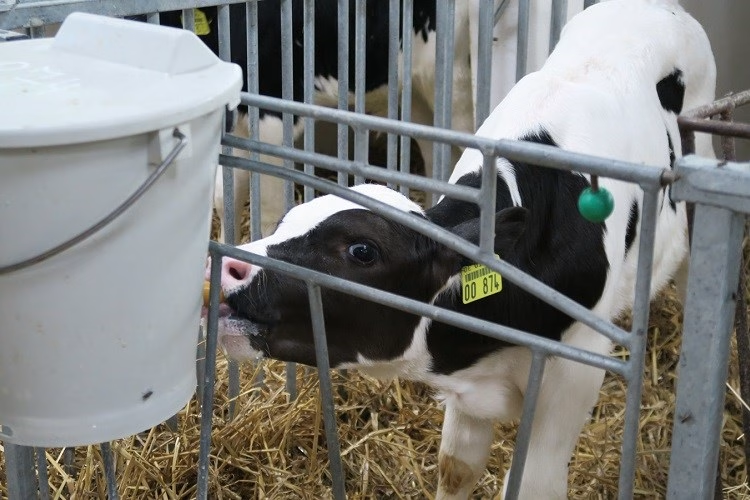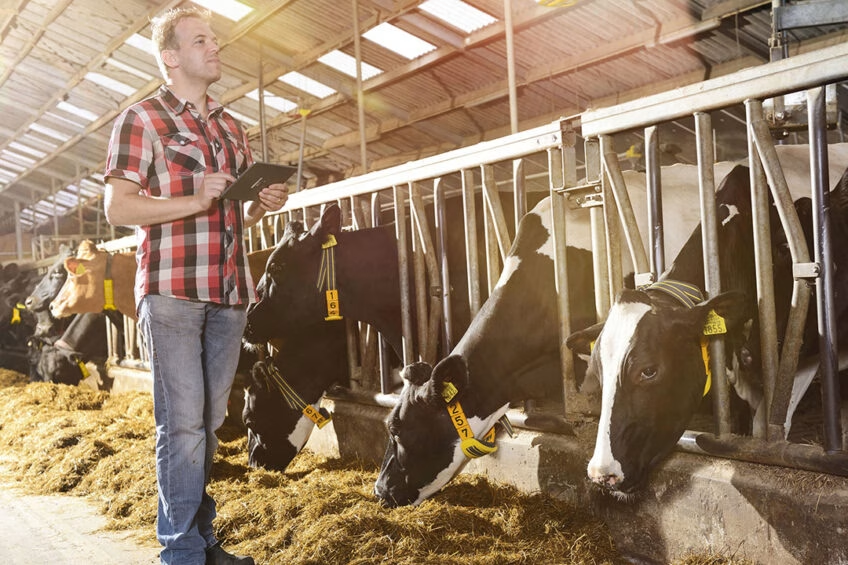Learn how modern weaning can improve calf health and boost your farm’s success. Ready to enhance your herd’s performance?
Summary: Weaning is a crucial stage in calf development, impacting the health and performance of the herd. A recent study found that calves with ongoing access to the milk-feeding system had 30% less weaning anxiety than those suddenly weaned. Optimizing weaning strategies can increase post-weaning weight gain by 12%, benefiting calf well-being and profitability for dairy farmers. Effective weaning can lead to higher immunity and reduced stress for young calves, while poor practices may cause a “post-weaning slump,” resulting in decreased weight growth and increased illness risk. Gradual weaning reduces stress as calves eat better, lowering distress behaviors and potential health issues. Technological advancements are revolutionizing procedures, providing tools to assess growth rates, health records, and feed efficiency.
- Calves with continued milk access experience significantly less weaning anxiety.
- Optimized weaning strategies can boost post-weaning weight gain by 12%.
- Effective weaning enhances calf well-being and farm profitability.
- Gradual weaning reduces stress and improves calf feeding behavior.
- Technological advancements aid in monitoring growth, health, and feed efficiency.

Have you ever wondered why specific dairy farms prosper and others struggle? One important consideration is the health and performance of their calves. Calves, the foundation of every dairy enterprise, symbolize the herd’s future and, eventually, the farm’s profitability. A recent study emphasizes the importance of weaning strategies in calf development, implying that novel techniques might substantially influence their performance, behavior, and general health. For example, calves with ongoing access to the milk-feeding system had 30% less weaning anxiety than those suddenly weaned. A study published in the Journal of Dairy Science found that optimizing weaning strategies can increase post-weaning weight gain by 12%, benefiting both calf well-being and profitability for dairy farmers. With innovations in weaning procedures, we now have a lot of information to enhance calf raising. Many dairy producers have been looking for a game changer, and adopting these novel practices might be it.
Optimizing Weaning: Paving the Path to Calf Success
Weaning is an important milestone in a calf’s life, indicating the transition from infancy to adolescence. Treating this shift may significantly influence their future development, health, and behavior. Effective weaning is more than a farm duty; it may lead to higher immunity and reduced stress for young calves.
Calves weaned at 17 weeks have a seamless transition from milk to a solid diet, resulting in improved development and weight increase. Poor weaning practices, on the other hand, might cause a “post-weaning slump,” resulting in decreased weight growth and increased illness risk (Transforming Young Heifers).
Calves exhibit reduced stress and eat better when weaned gradually, which reduces distress behaviors such as loud calling and low feed intake (Calf Rearing Excellence). Health implications: Stress during weaning causes respiratory and gastrointestinal problems, limiting their development and future output.
Combining increased pre-weaning food and progressive milk decrease, strategic weaning strengthens calves’ immune systems, resulting in healthier, more robust ones. Implementing evidence-based weaning procedures helps calves survive and become valued members of the dairy herd.
Out with the Old: Embracing Modern Weaning Practices for Healthier Calves
| Aspect | Traditional Weaning Practices | Modern Weaning Practices |
|---|---|---|
| Weaning Age | Fixed, typically around 8-10 weeks | Flexible, can be adjusted based on calf readiness, often earlier |
| Feeding Strategy | Gradual decrease in milk over several weeks | Milk and solid feed were introduced concurrently with the step-down approach. |
| Monitoring | Less frequent, based on age milestones | Constant tracking of individual calf intake and health |
| Health Focus | Primarily nutritional adequacy | Comprehensive, incorporating welfare and stress reduction |
| Resource Allocation | Higher labor and time requirements | Optimized to balance labor, efficiency, and calf well-being |
Weaning is vital in a dairy calf’s development, affecting its growth, health, and future production. Traditional weaning procedures, which generally begin around 8-10 weeks of age, focus on a steady reduction in milk over many weeks. While this strategy offers enough nourishment, it often falls short regarding individual calf health and welfare monitoring.
On the other hand, modern weaning procedures are more adaptable and flexible, with calves frequently weaning early if they are ready. This strategy combines the contemporary introduction of milk and solid meal with a step-down approach, resulting in a smoother transition. Continuous monitoring of every calf’s intake and health is critical to this technique, ensuring that each calf’s demands are immediately satisfied.
Traditional techniques have considerable drawbacks, including increased work and time requirements. Farmers must devote significant attention to decreasing milk and progressively tracking age milestones. On the other hand, modern procedures maximize resource allocation by striking a balance between worker efficiency and calf welfare. Metrics and case studies demonstrate that current weaning approaches increase calf health, minimize stress, and simplify labor and expenses.
Finally, contemporary weaning procedures may produce healthier, more robust calves while increasing farm efficiency. Transitioning from conventional to evidence-based approaches is essential for a more sustainable and productive dairy farming future.
Implementing Strategic Weaning Practices: Nutrition, Timing, and Stress Reduction
Implementing modern weaning practices requires a strategic approach, focusing on nutrition, timing, and stress reduction. Here are the essential steps to guide you in this transformative process:
- Gradual Transition: Begin by gradually reducing milk intake over time while increasing the availability of solid feed. This allows calves to adapt to solid feed consumption without the stress of an abrupt change.
- Monitor Nutrition: Ensure the solid feed is nutrient-rich and palatable. High-quality starter feeds and forages should be readily accessible to support optimal growth and transition. Regular monitoring of feed intake and calf health is crucial during this period.
- Timing is Key: The ideal weaning age can vary, but many experts recommend starting the weaning process between 6 and 8 weeks. Observing the calves’ readiness based on their solid feed intake and overall health is essential in deciding the right time.
- Minimize Stress: Stress reduction techniques include maintaining a consistent environment, gentle handling, and avoiding additional stressors, such as transportation or dehorning during the weaning period. Fostering a calm environment can significantly enhance the weaning experience.
- Monitor Health Continuously: Pay close attention to signs of illness or distress. Regular health checks, vaccinations, and parasite control are crucial during weaning to ensure calves remain healthy and thrive.
- Use of Technology: Implementing automated feeders, health monitoring systems and data analytics can help optimize the weaning process. These tools provide invaluable insights and ensure each calf’s needs are met efficiently.
Dairy farmers can successfully transition their calves by following these steps, ensuring better growth, health, and productivity. Embracing modern weaning practices benefits the calves and enhances overall farm efficiency and success.
Modern Weaning Techniques: Evidence-based Insights and Farmer Success Stories
Recent studies, notably the incisive research published in the Journal of Dairy Science, highlight the need to use current weaning procedures. These studies have shown that when given various feeding regimens, early-weaning, mid-weaning, and late-weaning groups had different effects on growth, behavior, and general health.
Early weaning procedures may save expenses and labor needs while maintaining calf health. A significant discovery from Western Australia demonstrates how optimal weaning ages boost development rates and fertility in pasture-based Holstein-Friesian and Jersey heifers (Journal of Dairy Science, 2023).
Real-life examples support these scientific findings. One farm in the Southwest successfully utilized a gradual transition weaning program that reduced weaning stress and enhanced long-term growth rates (Journal of Dairy Science). Using concentrated eating as a weaning signal, Holstein-Friesian calves performed better after weaning, avoiding the dreaded post-weaning slump.
A Holstein dairy calf management case study found that specialized feeding tactics throughout the pre-weaning period resulted in improved growth metrics and healthier blood parameters after weaning. This conclusion is consistent with more extensive studies supporting individualized milk-feeding strategies to improve weaning transitions (Journal of Dairy Science).
These research and practical applications provide vital information for farmers looking to improve their weaning procedures. Check our Boosting Dairy Herd Longevity and Calf Calf Raising Excellence materials for a more in-depth look at comparable revolutionary ideas.
Revolutionizing Weaning: Harnessing Technology for Healthier Calves and Better Productivity
Technological advancements are transforming conventional weaning procedures, giving dairy farmers tools they could not have imagined a few decades ago. Implementing this technology may improve calf health, performance, and general well-being during crucial weaning.
Automated Feeders and Milk Replacers: Automated calf feeders and milk replacers guarantee that calves get enough nourishment at regular intervals. These devices may be set up to progressively decrease milk consumption while boosting solid feed, simulating natural weaning processes, and lowering stress.
Health Monitoring Devices: Wearable devices, such as intelligent collars and ear tags, may track vital indicators, activity levels, and rumination patterns. These sensors enable farmers to identify abnormalities from typical behavior, such as decreased eating or activity, which may be early warning signs of health problems.
Data Analytics and Software: Farmers may assess growth rates, health records, and feed efficiency using farm management software, which integrates data from numerous monitoring systems. This complete picture enables better-informed decision-making and quicker actions.
Using technology in weaning improves healthier calves and allows for more efficient and lucrative dairy production. Using these modern techniques, farmers may ensure a smoother transition for their calves, therefore improving welfare and production.
The Bottom Line
The thorough examination of weaning strategies demonstrates these approaches’ significant influence on dairy calves’ general health, temperament, and performance. Adopting contemporary weaning practices based on scientific facts promotes healthier calves and lays the basis for a more profitable dairy enterprise. Farmers may increase calf well-being and farm performance by combining enhanced nutrition, cautious scheduling, and kind handling. It is a call to action for all dairy farmers to reconsider and implement these novel approaches to ensure the success of their cattle and livelihoods.
In this comprehensive guide, we explore how updated weaning practices can significantly impact dairy calf performance, behavior, and health. Through in-depth insights and evidence-based recommendations, various influential studies are dissected to pinpoint optimal strategies, from timing and nutrition to technological advancements. By highlighting modern techniques and success stories from experienced farmers, the emphasis is placed on creating healthier and more productive calves. The bottom line underscores the pivotal role of strategic weaning in the overall success of dairy farming operations.












